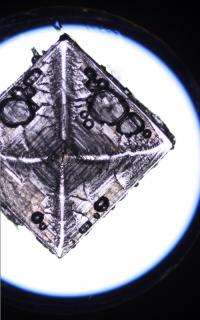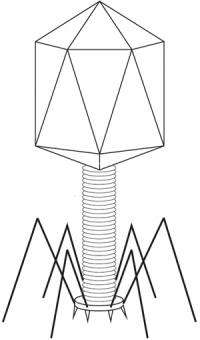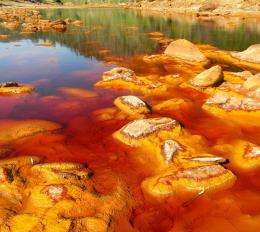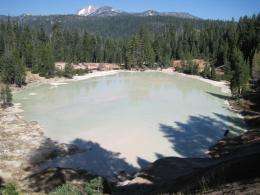In search of virus fossils

Here's a theory for a comedian to consider: dinosaurs done-in by avian flu. Silly as that may be, we imagine that viruses have been infecting organisms since life first appeared on Earth, but this is mostly just a hunch. New research is studying whether special environments (not related to dinosaurs) could potentially preserve vestiges of ancient viruses.
A census of all the current living organisms would show that viruses outnumber everything else 10 to one. Whether this was true long ago is uncertain.
"There is no known evidence of viruses in the rock record," says Jennifer Kyle, a postdoctoral fellow at NASA Ames Research Center and Portland State University. "Due to their small size and lack of a metabolism, many scientists assume that [viruses] would not be preserved."
However, viruses have distinct morphologies and chemistries that could be distinguished from those of their hosts. The trouble is where to search for these viral remnants.
With funding from the NASA Astrobiology Institute, Kyle and her colleagues will test whether viral biosignatures can survive in high-silica hydrothermal ecosystems and evaporative brines. These areas are known to be good for preserving microbe remains.

Moreover, these particular environments may be the first place we look for life on other planets, so it would be worthwhile to know if a Martian virus (if such ever existed) could have left a trace of its existence.
Longtime enemy
Comprised of a small amount of DNA or RNA wrapped in a thin protein coat, viruses would seem to be needles in the ecological haystack. They do not even clearly qualify as "life," since they are entirely dependent on a host to provide them with energy and biological building blocks. They really are little more than a set of plans for hijacking a cell's own life-support mechanisms.
Whether alive or not, viruses are quite effective, and they've probably been so for a long time.
"We believe the first viruses evolved around the time that life evolved," Kyle says.
Kyle and her colleagues recently found evidence of viruses associated with minerals in the water of the Rio Tinto in Spain, but no one has yet dug up a fossil of an ancient virus.
There are, however, many historical examples of parasitism. Parasite eggs have been isolated from preserved human feces, and lice have been found in mummified tissues. Going back further in time, some insects trapped in amber carried parasites with them to their grave. And certain plant fossils show signs of galls, which are tissue growths in response to a parasite.
Parasitism may indeed be synonymous with life. "Almost all life-simulations generate parasites relatively rapidly," says Ken Stedman, also from Portland State University, who is the PI of this research project.

We do have circumstantial evidence that viruses existed long ago. All organisms today are infected by at least one type of virus, which would argue that they have been our "evolutionary companions" through time. Sometimes two different species carry viruses that are very similar (like human small pox and cow pox), which suggests that the common ancestor of these hosts was infected by a common ancestor of the viruses.
Another clue to the long history of viruses is that many organisms have incorporated viral DNA sequences into their genetic codes. For example, the human genome is made up of at least 8% viral DNA. This sort of genetic "co-mingling" wouldn't happen overnight.
Viral signatures
If direct proof of past virus activity could be found, biologists might begin to unravel where viruses came from.
"Did viruses function the same way millions of years ago or did they evolve to more modern forms of replication?" wonders Kyle. "What kind of massive die-offs did viruses cause and is there a record of this?
One way to explore the history of Earth's microbial communities is to look for their chemical remains. For example, when geochemists find an organic compound called hopane in rocks, they can assume it comes from ancient cyanobacteria.
To increase the probability of a viral marker being preserved, Kyle and her colleagues will focus their attention on lipid-containing viruses. Lipids are molecules with long carbon chains that can survive for millions of years in geologic settings. Kyle says that many viral lipids are distinct from their host's lipids, thus improving the chances of a unique identification.
The team will test how well lipid-containing viruses hold up in microbe-preserving environments, such as evaporative brines. These dried-up salt beds are known to trap biological material in tiny liquid reservoirs called crystal fluid inclusions. Bacteria have been recovered from these inclusions and revived after having been "salt-cured" for thousands of years.
The same may be true for viruses. Viruses are highly abundant in the hypersaline environments out of which evaporative brines form.
Moreover, "the fact that viruses do not have metabolism and therefore lack the dependence on external nutrients and energy sources may enhance their chances of survival," Kyle says.

To check for viral survival in these brines, the team will place a "salt-loving" virus in a saline solution and then evaporate the water. They will then search with a microscope to see if any viable viruses remain in or on the surface of the salt crystals.
The second environment the team will study is around hot springs that are high in the element silica. Silica deposits have been found to entomb microbial cells. Over time, these glassy graves preserve morphological or chemical signatures of the cell and its contents. So if one of the contents happen to be a virus, then presumably it will be preserved as well.
"We just need to figure out what type of biological signature the viruses are leaving behind," Kyle says.
The group will be going to Boiling Spring Lake in California to search for lipid-containing viruses that may thrive there.
Astro-virology
Jack Farmer of Arizona State University, who is not involved with the project, believes Kyle and her colleagues have picked good places to hunt for viral biosignatures.
"Geological environments, which sustain rapid mineral precipitation that is contemporaneous with biological activity, provide an optimal circumstance for capturing and preserving fossil biosignatures," Farmer says.
Hot springs and high-salt brines are both swimming with viruses, so he thinks there's a good chance that something will get "stuck" when the local minerals form.
The same may be true on other planets. Farmer is a strong advocate of micro-fossil hunting as part of future Mars exploration. The Mars Science Laboratory (MSL), which is scheduled to launch in November, will carry instruments that can find carbon compounds in rocks. But Farmer believes this is only the first step.
"Where viruses are concerned, there is still much work to be done, experimental and otherwise, to understand the preservation potential and instrumental sensitivities needed for detection," Farmer says. "Finding viral biosignatures in ancient deposits on Earth will be an important step in assessing the potential for Mars."
Source: Astrobio.net



















